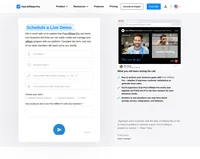Commissions are the backbones of affiliate programs. Affiliates naturally want to know how much they will earn for their hard work. Deciding how much you’ll pay them is one of the most important decisions you’ll have to make. And we mean it – their commission level is directly related to their motivation. Once you figure it out, it should all be smooth sailing – at least when it comes to financial matters, right?
Well, there’s one more thing that you might have to consider–split commissions. They can help make your affiliates even happier at little to no cost for you.
Wait, what is wrong with the traditional affiliate commission model?
When it comes to paying your affiliates, one of the most commonly used models is simply paying your affiliates a percentage of the purchased product’s price after successfully persuading someone to buy it. So if you sell a product worth $100 and the commission rate is 10%, your affiliates earn $10 for each sale they generate. Straightforward.
Another quite popular model is the tiered commission. In this model, affiliates get a bonus added to their earnings or are moved to a higher commission group once they meet specific criteria. For example, the affiliate might earn 10% commission for now, but once they make 100 sales or hit a particular sales revenue goal, they will move up to 15%. This model is advantageous when you want to motivate your affiliates to give it their all – the better their results are, the more they can earn.
So, where is the problem? Only one affiliate earns the commission in both of those payment models – usually the one whose link the customer uses to purchase a product. So, the problem resides with thinking that each customer sees only one specific piece of affiliate content, becomes convinced to try out the product, and clicks on an affiliate link to buy it. However, this is not the right approach.
Purchasing happens in multiple step
Customers have many places to find product reviews and comparisons, which means that finding someone who’ll buy a product or service straight after learning about it is almost like hitting the jackpot.
According to Trustpilot, 89% of consumers research a product for reviews and comments before purchasing it. Bizrate Insights found that 56% of customers read at least 4 product reviews before making a decision. As such, it’s far more likely that a customer will read several reviews before clicking on an affiliate link (rather than reading a single blog post and then making a purchase).
These findings indicate that a customer may come across materials published by two or more of your affiliates – for example, a blog post and a social media review. It wouldn’t exactly be fair if only the blogger got paid a commission fee while the other earned nothing, right?
Let’s say a potential customer is interested in electric pruning sears. They come across a blog post from one of your affiliates (let’s name him Matt). The potential customer isn’t sure whether they want to buy the product yet, as they need more information. So they leave the blog and read some product reviews.
Then, they find a video review of the same shears in which another affiliate of yours (called Tom) shows how he used the product to prune the bushes in his garden. The potential customer clicks on the video description link that takes them to the product’s website. They check out the current price and exit the site without making a purchase. Later on, the customer also finds the same shears mentioned on a gardening message board. You also have an affiliate who posts there (his name is John) and regularly uses those same shears to take care of his garden.
Now, convinced that they want to buy the shears, the visitor returns to Matt’s gardening blog thanks to all of the positive reviews. They remember that Matt said there’s a special discount on the shears if they are bought via his affiliate link, and so that’s what the visitor uses to buy them.
What is Split Commission?
Now here’s the question: who should get paid commission for the sale of the shears?
With a regular payment structure, the only person who would be rewarded is Matt since the customer purchased the shears through his link. But Tom and John also helped the customer make their final purchasing decision by reviewing the product and sharing their favorable opinions. Shouldn’t they also be compensated for their efforts? Of course, but giving each of them the same commission might have awful consequences for your budget.
Post Affiliate Pro has a clever solution to this dilemma, called SplitCommission™. This feature allows you to reward all affiliates that take part in each sale. This feature also allows you to set how the fee should be split between affiliates. Based on the option you pick, the tool will divide the payment between all eligible affiliates equally or award special bonuses to the affiliate who made the actual sale.
How the SplitCommission™ feature works
In the SplitCommission™ feature window (available through your merchant panel in Post Affiliate Pro), you will see three input fields: First Affiliate Bonus, Last Affiliate Bonus, and Minimum commission. (Your affiliates will be rewarded based on the variables you input in each field.)
Let’s say that five affiliates took part in a product sale, and all of them are eligible for a share of a $100 commission fee. How can you split it, and how much will each affiliate get?
- Equal commission for all eligible affiliates: If you don’t fill in the first and last affiliate bonus fields, the fee will be split equally, meaning they will get $20 each.
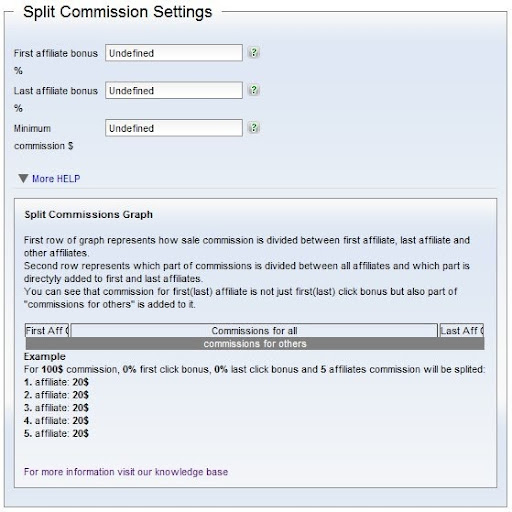
- Bonus commission for the first affiliate: If you fill in the first field but not the second, then the first affiliate will get a set percentage of the fee, and the rest will be split equally amongst all affiliates. Let’s say you specify that the first affiliate will receive 50%. They will earn $50, and the remaining $50 will be divided equally among everyone, giving the first affiliate $60 in total.
- Bonus commission for the last referrer – To set this option, you need to fill in the second field with a number and leave the first field empty. So, if you decide that the last affiliate will get 20%, they will earn $20 out of the $100. The remaining $80 will be divided into five parts, and so each affiliate will get $16, giving the last affiliate $36 in total.
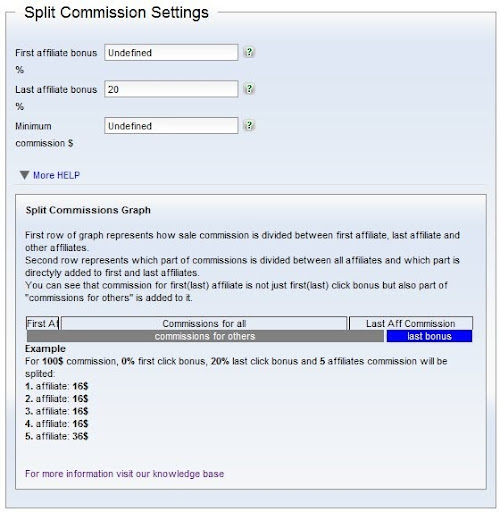
- Bonus commission for the first and last referrer – You also have the option to set a fee for both the first and the last affiliates. For example, let’s say that you want to give 25% of the fee to the first affiliate, 50% to the last affiliate, and the rest is to be shared equally. Then, the first affiliate will receive $25, and the last $50, with the remaining $25 split equally. This gives the first affiliate $30 in total, the last $55, and the other three get $5 each.
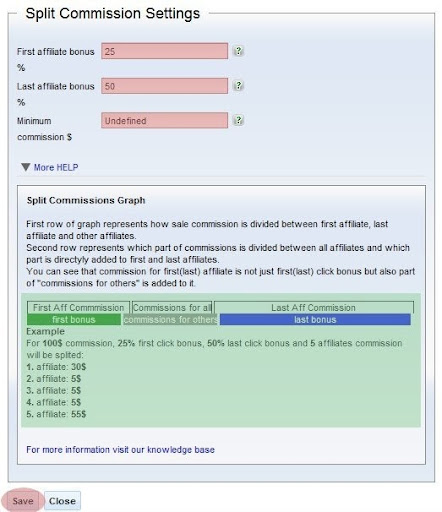
What about the last option? Through Minimum Commission, you can set the lowest amount each affiliate should earn from the split. This will help you avoid awkward situations when your affiliates get paid commission fees of $1 or less.
Why use the SplitCommission™feature?
Now you might think that this isn’t exactly worthwhile – wouldn’t your affiliates prefer to get the full commission rather than just a fraction of it? Well, split commissions are more beneficial for affiliates in the long run. With split commissions in place, your affiliates aren’t only earning money from the direct sales they make. They also get rewarded for any involvement in the conversion process. And if they know that every piece of content they create can help them get a share of the commission, it will be a great motivator for them to work harder.
The SplitCommission™ feature also helps you to count how much each affiliate should be earning. All you need to set up are the Split Commission rules, and Post Affiliate Pro will handle the rest.
Conclusion
Using split commissions in your program might be one of the best methods for engaging your affiliates.
Rather than getting paid for only direct sales, they will be rewarded for any activity that leads to a sale. And while the split payment might seem like a marginal fee at first glance, your agents will be earning commissions far more often. As a result, they will get bigger paychecks.
Of course, dividing the fee by hand would be far too much hassle for anyone. So sit back and relax while Post Affiliate Pro handles the math.
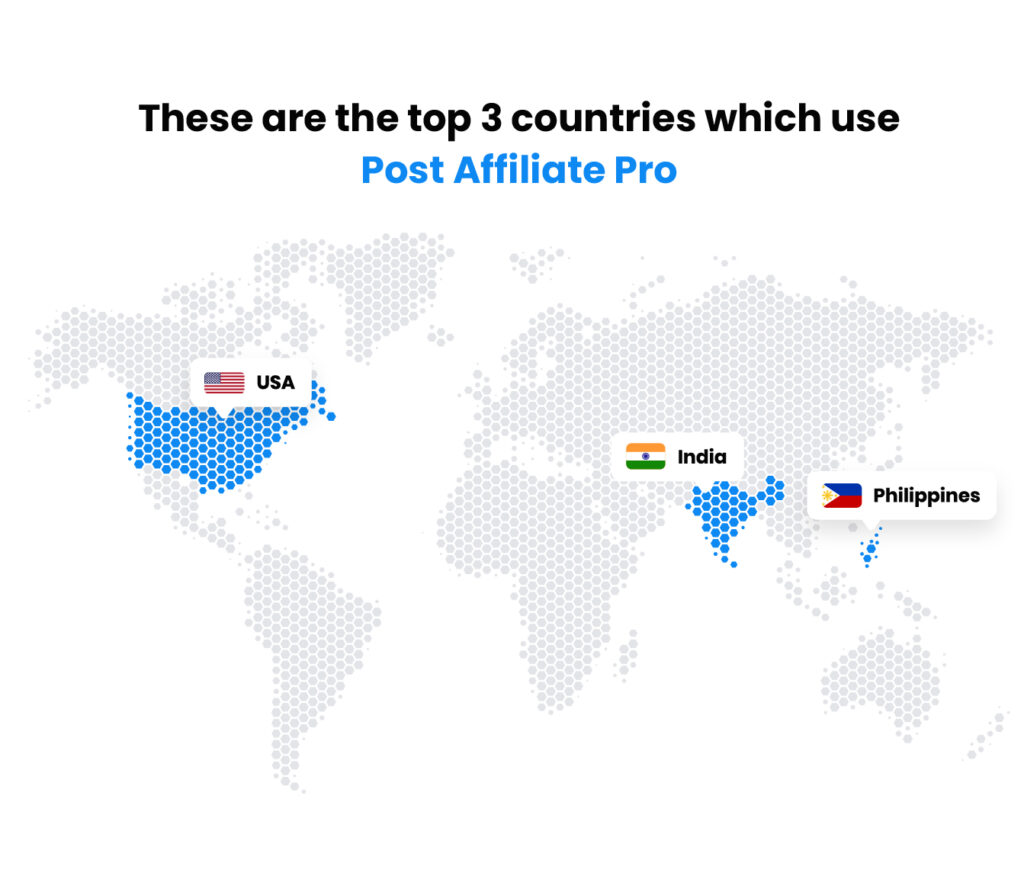
Share this article
Discover Post Affiliate Pro's flexible pricing plans tailored to fit your business needs, with options for Pro, Ultimate, and Network packages. Enjoy a free trial with no credit card required, no setup fees, and the freedom to cancel anytime. Benefit from features like unlimited affiliates, advanced reporting, customizable interfaces, and lifetime support. Save up to 20% with annual billing and take advantage of more than 220 integrations. Perfect for businesses seeking to enhance their affiliate marketing efforts. Visit now to find the ideal plan for you!
The leader in Affiliate software
Post Affiliate Pro offers a comprehensive affiliate software platform to manage multiple affiliate programs with ease. Enjoy no setup fees, 24/7 customer support, and a free 1-month trial. Ideal for small and large businesses, it features precise tracking, automated workflows, and customizable tools to boost your affiliate marketing success. Try it now and streamline your affiliate operations effortlessly!
Explore Post Affiliate Pro's comprehensive Affiliate Program Directory, featuring diverse opportunities with competitive commissions and flexible payout options. Discover programs across various industries, accept worldwide traffic, and elevate your affiliate marketing game. Join today and maximize your earnings!
Effortlessly integrate your e-commerce site with Post Affiliate Pro and boost your affiliate program's success. Our expert team ensures seamless integration with your payment processor, handling technical issues along the way. Enjoy a free trial and free integration service, saving you time and maximizing your ROI. Join now and experience top-notch affiliate management with over 500 integration options.







